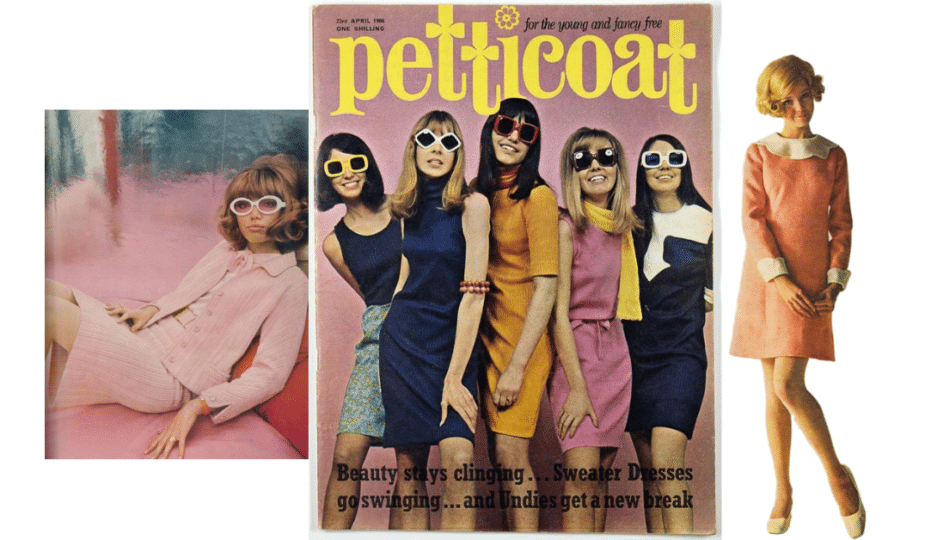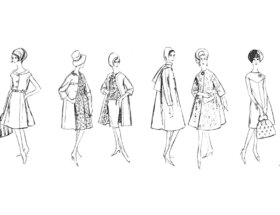By Pauline Weston Thomas for Fashion-Era.com
Talent was the prerequisite to success in the 1960s. For the first time ever in any fashion era, the young became the leaders of fashion.
They led with new and radically innovative fashion styles, with little girl woman androgynous looks for women that swept away the sophisticated sweater girls of the early sixties. The picture of Twiggy in the header defines her as the epitome of a sixties baby doll woman.
Fifties Fashion Hangs on until 1966
In the 21st century, it's easy to associate all 1960s fashion with short skirts, but the short skirt was not really worn by many until 1966 and not nationwide until 1967. Just as in the 1920s for half a decade clothes still showed signs of belonging to the late fifties.
The forerunner of the mini dress the straight shift, which had developed from the 1957 sack dress, was still well below the knee.
In the early sixties, pleated skirts set on a hip yoke basque were worn with short-sleeved over blouses which were cut not unlike the shell tops of today.
Straight skirts had front and back inverted pleats called kick pleats and were ideal for doing the twist dance craze as they allowed the knee to move freely. Straight sweater dresses in lambswool or the synthetic acrylic variety called Orlon were worn belted with waists nipped in became fashionable.
Pencil skirts were still worn with sweaters or even back-to-front cardigans that had been pressed super flat. Before the days of tumble driers many women lay their washed rung out knitwear in paper tissue and then brown paper.
They put it to dry under a carpet for two days. When it was removed from the tissue, the footsteps that had pounded over the knit gave it a flat dry cleaned as new appearance. Laundering of delicates could still be a problem, but everything changed when mass produced synthetic garments arrived.
Mary Quant and the Mini Skirt - Which designer introduced the miniskirt in 1965?
By 1966 Mary Quant was producing short waist skimming mini dresses and skirts that were set 6 or 7 inches above the knee.
It would not be right to suggest she invented the fashion mini skirt. In 1965 she took the idea from the 1964 designs by Courrèges and liking the shorter styles she made them even shorter for her boutique Bazaar. She is rightly credited with making popular a style that had not taken off when it made its earlier debut.
Quant found London girls seeking newness only too willing to try her new daring short mini skirt. The fashion trend took off because it was so different and to wear it well you had to be youthful to get away with an outfit that was so controversial, particularly among adults. The Quant style was soon known as the Chelsea Look.
You are reading an original 'The 1960s Mini Skirt' fashion article by Pauline Weston Thomas at www.fashion-era.com ©
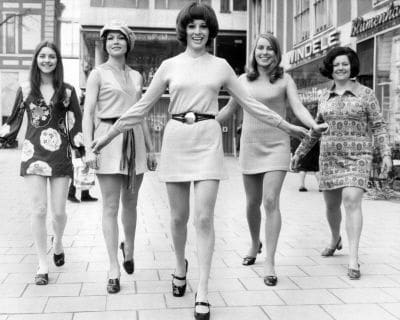
The shapes Quant designed were simple, neat, clean cut and young. They were made from cotton gabardines and adventurous materials like PVC used in rain Macs. They almost always featured little white girly collars.
The Mid-1960 Hairstyle
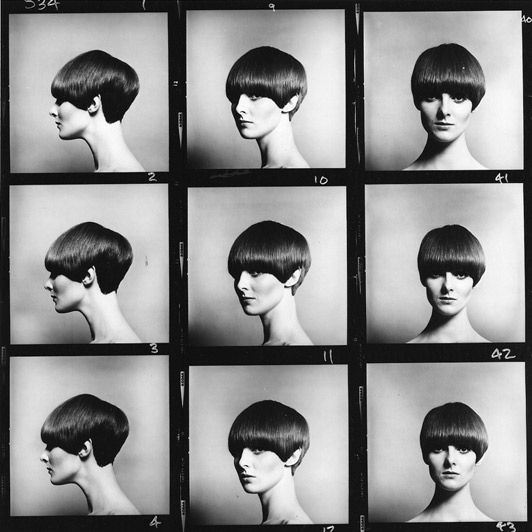
Mary Quant also sported a sharply cut geometric hairstyle. One of the most famous and favoured cuts of the era was the 5-point cut by Vidal Sassoon. The hairstyles and the short mine skirts and min dresses made the mid and late-sixties fashion look.
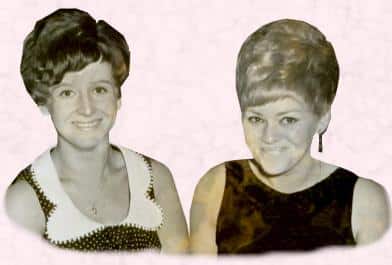
The Unsung Mini Skirt Inventor of the 60s- John Bates
John Bates was one of the most influential British designers of the 1960s. Ernestine Carter the fashion historian thought him the unsung inventor of the mini skirt.
His mini dresses were the shortest, had the barest midriffs and the models wore the least undergarments - he preferred a bra-less silhouette. In 1959 he set up the Jean Varon label and later a label under his own name.
His influence in the sixties was such that he dressed Diana Rigg in The Avengers series. Other celebrities of the day such as Twiggy, Sandie Shaw, Jean Shrimpton and Dusty Springfield all wore his fashion designs. But so did the masses as he also designed for important key department stores in the UK.
John Bates has never been given enough credit for his role in the rise of the mini skirt. The facts are that John Bates was making shorter skirts long before others. But Mary Quant was the facilitator of this novel idea and was really noticed. She got the mini skirt out among trendy young girls about town and it soon became copied and popular everywhere.
Quant was copied everywhere and another famous name of the sixties was Barbara Hulanicki of Biba. Biba of course was a sixties hit with girls who loved fashionable and funky looks at a value price.
That Was The Week That Was
The London TV Saturday night programme 'That Was The Week That Was', watched by half the UK nation had some time earlier shown a model wearing a dress with a belt that enabled the model to lift the dress up showing the possible various shorter lengths that designers were forecasting hemlines would rise to in the next six months.
The audience laughed and gasped and viewers across Britain tittered, but within less than a year the shorter length was firmly established with under twenties and soon after their mothers too began wearing a short mini skirt.
Typical of the era the opening lines of the show were 'that was the week that was, it's over let it go...'
It was typical of the 1960s attitude of let's get on with the future, making it a very fast-moving decade in fashion, lifestyles, innovations and morals. The fashion mini skirt became one of the icons that symbolized this era.
You are reading an original 'The 1960s Mini Skirt' fashion article by Pauline Weston Thomas at www.fashion-era.com ©
Death of Stockings
What made the mini really acceptable was the introduction of pantyhose known mostly today as tights. It was hard to wear a mini dress with stockings and feel confident, but with tights there was protection from the elements and no unsightly glimpse of stocking tops. Stockings died in the mid 1960s and were only revived as leg wear in the 1990s or else kept for the bedroom.
Pantyhose
When tights were first introduced in the 1960s they liberated women from girdles, roll-ons and suspender belts. It's difficult to know which came first the skirt or the tights, but the introduction of seamless stockings had started the tights revolution. What is certain it is unlikely that one could have existed without the other as no groomed young lady ever went out bare-legged then.
A pair of Wolsey tights cost about £1 in 1965 and with careful daily washing they could be made to last a month. Marks and Spencer were soon churning out lower-cost versions. Obviously planned obsolescence has been introduced since then for all brands, as most of us now find it difficult to make them last for more than a day or two's wear.
Tights in the late 60s were often patterned with arrangements of diamonds or other motifs and a favourite colour of the era was a golden brown called American Tan. Fishnet tights were also popular briefly. Lurex glitter tights in gold or silver were a hit for the Christmas period.
1960s Footwear
Lower kitten heels were a dainty alternative to stilettos Pointed toes gave way to chisel-shaped toes in 1961 and to an almond toe in 1963.
Flat boots also became popular with very short dresses in 1965 and eventually, they rose up the leg and reached the knee. A cult for Dr Scholl clogs sandals worn in offices and outdoors was all the rage in the mid to late sixties in the same way that Birkenstocks were popular in the 1990s.
Pinafores and Knits
Knitted twin sets were still worn, but often the items were worn as separates. Square, V or round neck pinafore dresses in plain or tartan wool fabrics were teamed with polo neck jumpers or tie-neck blouses. Other combinations were burgundy plum pinafores worn with white or mustard blouses.
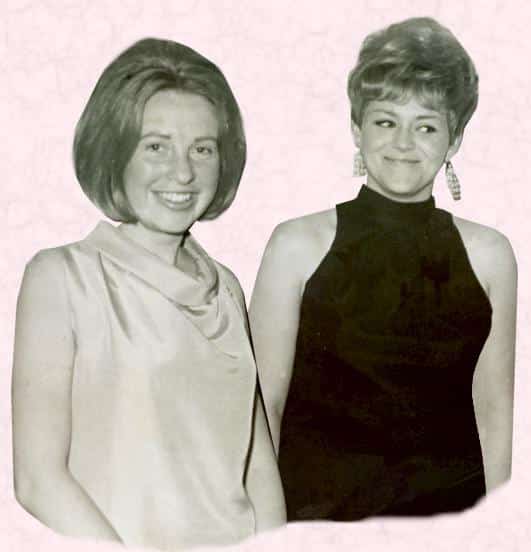
A sleeved variation of the button-through version of the pinafore was called a coat dress and it was worn with or without a skinny rib-fitting sweater. It was often worn with a half belt at the back waist.
All clothes were narrow-shouldered and cut in at the armholes to properly reveal the arm and its shoulder joint. Even short sleeve versions were set well into the armscye.
Baby doll dresses of 1966 were full and flared into tent shapes mostly with cutaway armholes or/and a halter neck.
They were made of transparent tulles, lace or chiffons plain or tree bark mounted over a matching lining or could be made of crinkled cotton crepe fabrics.
Lace of all types from Broderie Anglaise to guipure to crochet effects over coloured linings or flesh-toned linings were often seen.
Black polo neck sweaters made popular by the Beatle's cover album were often worn under check pinafore dresses. The dresses were usually solid colours of red or purple wool material. Checks of black and white such as dog or hound's-tooth or Prince of Wales check.
Black and white was a sixties combination and was used in op art dresses and block pieced dresses worked in Mondrian style. Black patent accessories complimented all these combinations.
One of the easiest ways to get the sixties look was to wear short little coloured gloves with a hole cut out to reveal the back of the hand. The gloves were similar in appearance to the golf gloves of today. With the gloves coloured plastic beaded raffia knit bags and plastic coloured bangles and chandelier earrings made of large sequin discs were all high fashion accessories that lasted about 5 years.
All of these trend-setting outfits and accessories could easily be obtained from Wallis, Richards, Etams, Biba or Chelsea Girl shops.
Marks and Spencer did their bit and brought a shorter young junior range to teen girls in an effort to cut the cost. The range did not have the added-on adult purchase tax that clothes had in pre-VAT days.
You are reading an original 'The 1960s Mini Skirt' fashion article by Pauline Weston Thomas at www.fashion-era.com ©
Outdoor Clothes
Outdoor looks were achieved by using fabrics like wool, Terylene or cotton gabardine, corduroy, leather, suede or mock suede fabrics made up as car coats. Also, cheaper alternatives such as padded nylon diamond quilted anoraks or cotton anoraks with toggles and Austrian peasant embroidered braids were quite common.
Trousers
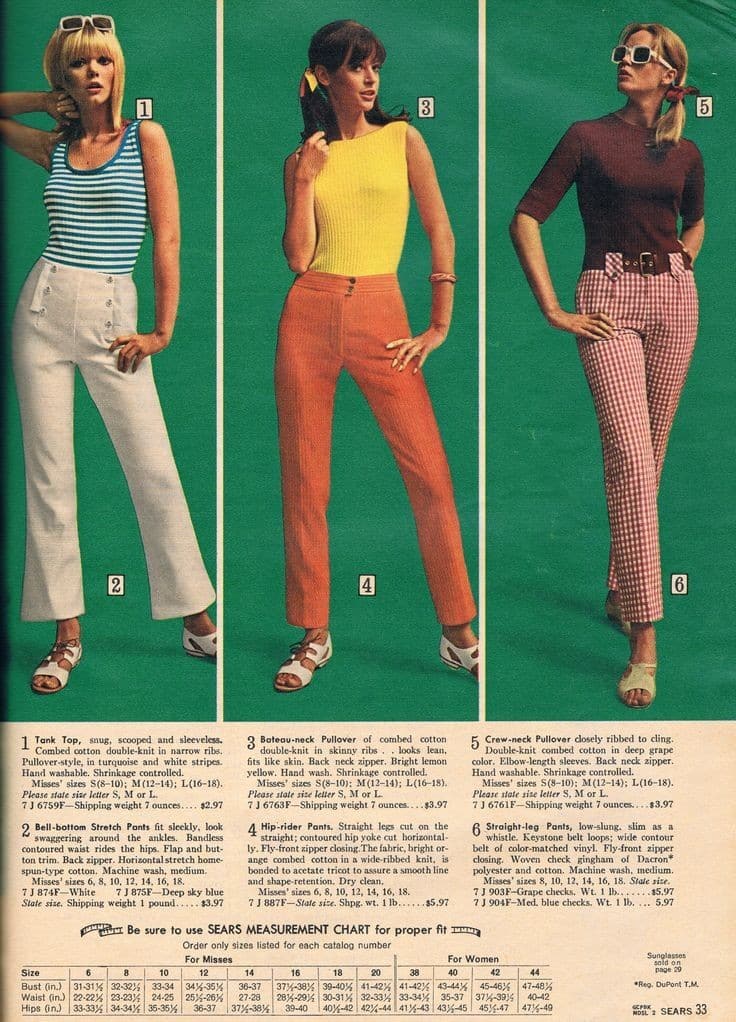
The mini dominated fashion and women sometimes needed a practical alternative smarter than jeans that could be worn day or evening.
Quite formal trousers worn with a tunic, shirt, skinny rib, or matching suit jacket were acceptable in certain work situations and liked as alternative evening wear when made from slinkier materials.
Trousers were made from Courtelle jersey, cotton velvet, silky or bulked textured Crimplenes, lace with satin, and Pucci-style printed Tricel.
Hipster versions were popular and very flared versions developed by the late sixties, with every style ultimately translating into denim jeans. It's worth noting that the hipsters of the 60s were not quite as low cut along the pelvic line as the low-rise jeans of 2005.
So Many Influences on 1960s Styles
Many things influenced fashion in the 1960s. Social mobility, daring fashion photography, easier travel abroad, the Vietnam war, new music of the Beatles and their much-copied hairstyles, retro military and ethnic clothes, musicals, pop art and film all played a part.

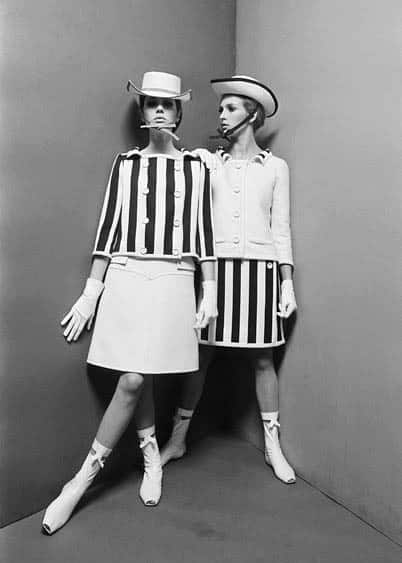
I have already looked at Mary Quant and the role of pantyhose, but other major 60's influences included the trend-setting globally photographed Jackie Kennedy.
In addition, Emilio Pucci's exotic psychedelic beautiful fabric prints, and Courrèges's space-age sculptured designs were as important as the fresh approach to fashion as that of Yves St. Laurent.
The then youthful designer Yves St.Laurent made a clean forward looking fashion design image with his Mondrian inspired dress.
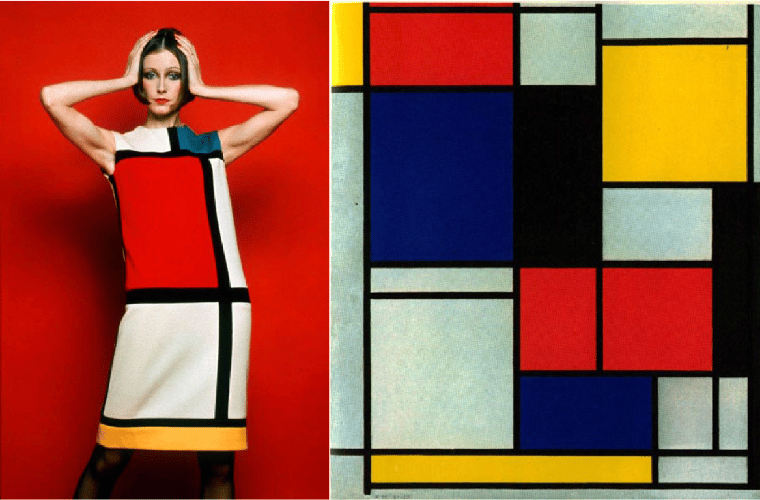
Rock Around the Clock
By the 1960s the Twist, the Shake and the Locomotion ousted the paired dancing couples of earlier generations.
Only for the last few dances of the evening was the Smooch allowed for couples to romantically hold each other as they made their play to walk a partner home. Some stalwarts continued to rock and jive and to wear Teddy Boy gear.
New Synthetic Yarns in the 1960s
Many of the fashions of the 1960s existed because of the fabrics. They introduced new fabric properties and when synthetics were mixed with natural fibres there was improved performance in wear. Some had been invented years earlier in the 1930s and 1940s, but it was only in the 60s that huge production plants for synthetic fibres sprang up globally.
In the UK in the 1960s Marks and Spencer was instrumental in bringing Elastomerics from America to their range of bras, corsetry and bathing wear. Other manufacturers and fashion retailers soon followed.
Meanwhile, as man-made fibres gained a hold, the Yorkshire woollen industry began to contract at an alarming rate. Job losses were inevitable and yet so often the newer man-made yarn companies settled in areas where there was already a body of knowledge and a heritage of spinning, knitting or weaving.
Du Pont and ICI were the giants of synthetic manufacture producing a wide range of fabrics under trade names relating to Polyamide, Polyesters, Polyurethanes, Polyolefins, and Polyacrylonitriles the polyvinyl derivative. All the fibre bases could be used as bulked or fine yarns depending on the fibre extrusion method and final finishing.
The name is often related to the country or plant where the fibre was produced for example Enkalon was Irish-made nylon whereas Crylor, an acrylic yarn was made in France.
Polyamide is nylon. It came under trade names such as Nylon 6, Celon, Enkalon, Perlon, Bri-Nylon, Cantrece and others. Polyester was known variously as Terylene, Dacron, Terlenka, Trevira, Kodel, Diolen, Tergal and Lavsan. Polyurethane is the generic name of the elastomeric family of stretch fibres like Spandex, Lycra and Spanzelle.
All these man-made synthetic fibres began to be used in bras, underwear, swimwear and sportswear. Lycra eventually found its way into fabric mixes to aid crease recovery, wearing ease, fit and stretch.
Polyvinyl derivatives produce polyacrylonitriles and this includes Orlon, Acrylic, Crylor, Courtelle and Creslan. Modified acrylics such as Dynel and Teklan were first used to make fake furs and fake hair for wigs in the sixties.
You are reading an original 'The 1960s Mini Skirt' fashion article by Pauline Weston Thomas at www.fashion-era.com ©
Biba History
In 1964 Barbara Hulanicki founded Biba with her husband. The team developed a small fashion shop in Abingdon Road, Kensington. The original Biba concept was the retail forerunner of low-cost value fast fashion today and the type of pieces found in Primark or George at Asda.
Biba sold low-priced versions of high-fashion items, particularly the Quant mini skirt. Biba and the Biba style of make-up application was also a huge sixties look. The Biba Art Deco store of the 70s was the place to be seen hanging out.
After expanding too fast, too soon, there were financial problems at Biba and Dorothy Perkins took a majority stake in the business in 1969. After some corporate machinations, Barbara Hulanicki left Biba and the trademark name in 1975.
Later the Biba business was sold again. Meanwhile, in the following forty years, Barbara Hulanicki has had a successful career in both interiors and fashion and continues to design from barbarahulanickidesign.com
As for Biba - in the late 20th decade, other licensees sold products under the Biba name. The label has a chequered past and after a much-heralded fashion revival again in 2006, the trademark fell at the post again and the owner went into administration in the 2008 recession.
In 2008 the UK department store House of Fraser acquired the Biba trademark name.
In October 2010 after a very successful launch and sell-out of some Biba pieces, House of Fraser declared Biba their top-selling fashion line.
You are reading an original 'The 1960s Mini Skirt' fashion article by Pauline Weston Thomas at www.fashion-era.com ©
